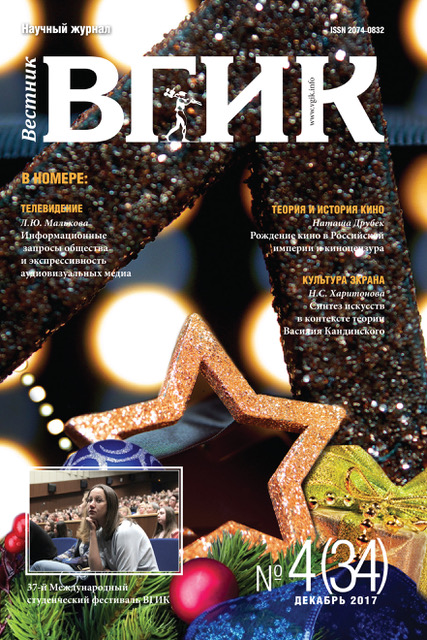Synthesis of Arts in Vasily Kandinsky's Creative Work
- Authors: Kharitonova N.S1
-
Affiliations:
- ВГИК
- Issue: Vol 9, No 4 (2017)
- Pages: 96-104
- Section: SCREEN CULTURE | CULTURAL STUDIES. PHILOSOPHY
- URL: https://journals.eco-vector.com/2074-0832/article/view/14621
- DOI: https://doi.org/10.17816/VGIK9496-104
- ID: 14621
Cite item
Full Text
Abstract
The author analyzes the processes associated with synthesis of arts at the turn of the 19-20th centuries basing on Russian artist Vasily V. Kandinsky’s creation. He felt a certain relationship between different kinds of art and the need for combining them to create something special, new and unique. For the first time, the artist wrote about this in his book Concerning The spiritual in art, where he articulated the idea of affinity of all kinds of art, especially music and painting. Defining pictorial art as a part of spiritual life that promotes the movement forward and upward, Kandinsky develops not only the theory of the influence of color and color combinations on the viewer, but argues that the form (abstract or geometric) has an inner sounding in turn. Thus, straight lines are youthful, the curves convey maturity, the point is a small world, the horizons sound cold and flat, the verticals are warm and sublime, sharp corners are warm, while straight lines are cold and austere. Vasily Kandinsky believed that the composition was a chord of colorful and picturesque forms that exist independently as such, which are caused by inner necessity and constitute the whole, called a painting. The artist claimed that our harmony is based mainly on the principle of color and sound contrast. Not accidentally, Vasily Kandinsky, noting a strong impression in his youth from Wagner’s operas, entered the Monogram signature on his works in the triangle, and used musical terms for titles of his works: improvisation, composition, Fugue, Concerto, Suite, and others. Defining the scenic arts as part of spiritual life, which contributes to moving forward and upward, Kandinsky developed not only the theory of color effects and color combinations on the viewer, but argued that the form (abstract or geometrical) has inner sound in turn.
About the authors
Natalya S Kharitonova
ВГИК
Author for correspondence.
Email: kharitonova4321@yandex.ru
PhD (Arts), Associate Professor, Department of Aesthetics, History and Theory of Culture, VGIK.
References
- Кандинский В.В. О духовном в искусстве. - М.: Архимед, 1992. - 112 с.
- Кандинский В.В. Точка и линия на плоскости. - СПб.: Азбука-классика, 2015. - 240 с.
- Турчин В.С. Кандинский в России. - М.: Художник и книга, 2005. - 448 с.
- Турчин В.С. Вибрирующая материя: теософия и музыка (Русский опыт художников, поэтов и композиторов) // Звук и образ. Трилистник. - М., 2002. - С. 38-48.
Supplementary files








